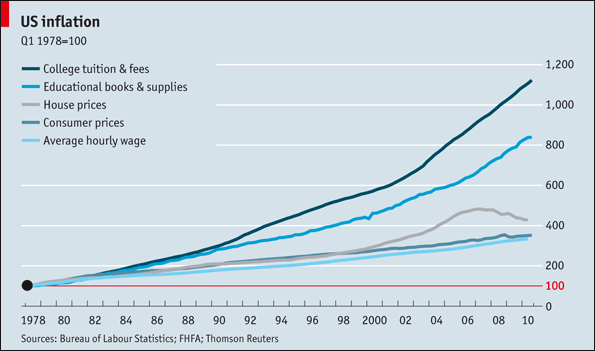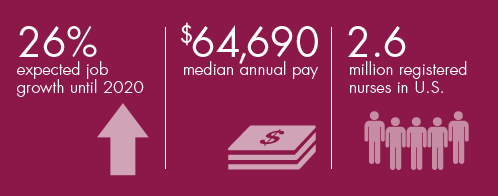It’s quite funny how tuition has been able to resist the laws of physics within the past years of recession. Unlike the mortgage industry where it took a nice dive south in 2008, tuition has been able to resist this urge and continues its leap. In fact for public schools the annual increase has been 6.5% each year for the past decade. However certain policies both fiscal and monetary are out there, but how much do they even help? If they don’t help at all I sure as heck would like to know of some alternative options to college that might provide more of a benefit in securing a financially secure future. While the public is told that colleges are a promising step to securing a financial future, the cost of tuition seems to act as a stump towards finishing the end of that promise. This stump hurts many aspects of society, mainly the middle class American dream. An important value that has become more demanded but less available to the public with some more than others.
After considering some numbers on this chart, it might seem that coming out of college in debt would most likely put the average college student few tens of thousands in debt and for some, many tens of thousands.

Considering that the average tuition for college graduates is around $45,000, it would seem that is very possible to manage the debts out of college. For loans taken after 2013, Obama’s new policy that fixes loan payments to 10% of monthly income will be able to ease the stress of paying back the loans. Unfortunately, this only covers federal loan debt, which is helpful considering that federal loans take up 90% of the student loan market. Yet, only around 1.5 million are even eligible to use President Obama’s “Pay as you Earn…” plan. This is because in order to qualify for the policy, a borrower must have an outstanding federal debt in comparison to their family size. This obviously helps the lower socio-economic borrowers, but this leaves a wide gap towards the rest of the “middle* (middle class is no longer middle class)” class borrowers –borrowers whom are actually the most worst off in terms of college loans. Because federal aid is limited to those who are in more well off financial situations, borrowers in this category must resort to private lenders, primarily like those of Sallie Mae.
Sallie Mae “also offers reduced monthly payments, extended repayment schedules, and likely some less-advertised hardship programs. In their letter to the CFPB, they also state that they are in favor of rehabilitation programs for private loans that can help borrowers recover from default.”
Yet after looking at the so many videos, blogs and comments , it’s obvious that Sallie Mae doesn’t have a practical way of helping borrowers. For that reason, it’s common to hear stories of loan debt from Sallie Mae being doubled and paying monthly rates of over 1500.
Tiffany, a borrower who has suffered the much too common problem comments,
“I’ve spoken to their reps many times and it seems they can never help or answer any of my questions. I asked them how much of what I do pay actually goes to the primary loan and how much goes to interest. that rep couldn’t answer me. Just said I don’t know and I’m sure your loans will go down. (they haven’t) they have actually almost doubled ($25,000) now ($45,000). I am now searching for outside help and hoping to get someone involved because it doesn’t seem right to do all these programs and the sum of the loan never [goes] down.”
Responses like these are all over loan assistance forums, blogs and YouTube.
What it comes down to is whether these loans are affordable to the borrower in a way that takes into consideration the most important factors of the economy. Is the borrower entering a sound financial market in the coming years? Will the economy shape up and provide enough quality jobs to sustain borrowers in their repayments? Are interest rates comparable to these factors?
Interest Payment
11.875% $197.92 $392.92 72 $33,753.19
Fixed Payment
12.375% $25.00 $414.73 96 $40,434.05
Deferred Payment
12.875% $0.00 $410.66 108 $44,185.09

These are all questions that answer themselves but have not been replied by the government or the institutions themselves. Obviously, with the current average salary of $45,000, repaying $30,000 would take over 15 years IF the income to ratio payment plan was available to use. One can only expect a borrower from Sallie Mae who is unable to use an income ratio payment plan to be in a much more difficult situation to say the least.This is the repayment plan for $20,000 loan. Why should a loan increase over double the amount when deferred? The deeper question is: Why would someone take out such a loan with the imposed risk of destroying oneself financially?
It’s about time that not only private lenders like Sallie Mae change their lending practices, but also borrowers become more responsible consumers by taking a stand against predatory lenders. But in reality this requires students to look towards other alternatives and sadly there are no real alternatives that provide such assistance. That means a lot of students would have to stop going to school and the future of college students would drastically drop in numbers.
Of course this adds the benefit of pushing for reform in creating alternatives to the whole post-secondary educational system, but the time that it would sacrifice would be much to dire for a single generation to make this move. Therefore, the only plausible solution would be for reform, like any sustainable reform, to happen slowly. This will act as yet another barrier to allowing current college debt holders from being able to pay their debts off.
If one was looking to find a solution in today’s market, one would have to focus on a career that is in demand and provides a secure return. Two of those jobs are nursing and teaching. Since baby boomers are now retiring a great number of those jobs are becoming increasingly in demand. These jobs even if requiring a large sum of debt are secure

This could create a major shift in the workforce where middle class Americans are fighting more for a secure workplace rather than their dream job. These attitudes already exist primarily in majors like pre-med, engineering and accounting but a severe shift into these jobs could create a problem of supply and demand in future generations. As of now, they remain as a credible option for securing a life as a middle class American and more importantly getting the bang for the buck.It’s unfortunate that the solution to the economic market requires overlooking the value of the educational institution and instead considering the conditions of the job market. It completely debases the goal of universities of spreading diversity, education and promising a future. Money is spread too far thin in America and economic security is only available in the holes in which it leaks. As nursing and teaching jobs are being widely pursued after, it is evident that more and more students are becoming aware of this fact.enough to pay off debts and provide a financially secure future.
Given that there are so many fields of careers in each of those industries that are increasing and decreasing at different paces, the prospect of the job market varies with holes that are both hidden and publicly evident. So looking for those things is important in order to really make a conscious decision in the future path of a post-secondary education. Within all these holes of mysteries and wonders the only way to really find a secure route towards careers, ones like public relations, journalism, business, philosophy etc. , institutions have to provide resources that cater to these fields –things like specific training and hands-on (internships) that give a more practical and applicable tool to the student.
The company, Coursera does this exact thing. Founded by Andrew NG, Coursera is a site that offers the “world’s best courses, for free.” This is an example of a tuition return at its finest. Free tuition and specific helpful resources. This helps employers as well as it locates them with specialized workers whose educational background can be used more accurately and in sync with what they are looking for. This also does tuition cost a service as an institution like Coursera has all the ability to compete with universities if they were to be recognized by employers. I hope sarcasm is ringing its bells, because a zero cost tuition could equate to a complete reform of the tuition market.
Naveed, an environmental engineer explains that Coursera is in a way
“recycling information within the educational system.”
Within all this commotion and episodic dialogue there is a piece of thought I hope to shed light on. The importance of college tuition has become emphasized more than ever in the past decade and yet it’s also the worst time to get one. Maybe in a couple years when alternative forms of education are properly institutionalized, one can expect to find a secure job without carrying a load of debt. As stated, this takes time and a lot of effort considering that colleges would not like to see their tuition costs diminish. But another important aspect to also consider is innovation. The great country of USA has been excelling in innovation, but education has yet to reap its benefits. But with technological advancements already taking place in companies like Coursera maybe one day Coursera might be referred to instead as an institution rather than a company or site.
An economy is only as good as the families that profit from it. And while, this may be the worst time in this article to get sensitive, protecting and nurturing families has always been the end goal of having a good economy. The economy should never discriminate against class, race or ethnicity but unfortunately that is not the case. With tuition costs expected to increase, society can only expect to continue redlining certain audiences of the public.
Certain audiences would fall under immigrants, minorities –first generation college students who are only beginning to transition into post-secondary system. The time is more important than ever for a revolution for integration to occur but that is difficult to do when private lenders like Sallie Mae thrive from these very people. There is obviously a lot of sewage that drains from college tuition, but the problems leak far deeper than publicly acknowledged and it is important time to begin looking into these matters.
Otherwise we are headed into a catastrophe that could yield devastating systemic blow to the educational system, financial system and government. Based on the history of America’s economic and political system, it’s now more than ever that the cost of education is hurting the economy more than ever.
___________________________________________________________________________________________
References
http://pnpi.newamerica.net/sites/newamerica.net/files/program_pages/attachments/college%20published%20tuition%20and%20fees%20chart%20year.png
http://aspanational.files.wordpress.com/2011/12/collegestuition.jpg
http://xmiragestat.files.wordpress.com/2014/04/higher-education-increase.gif
http://www.clearpointcreditcounselingsolutions.org/how-to-pay-off-private-student-loans-from-sallie-mae-and-other-lenders/

